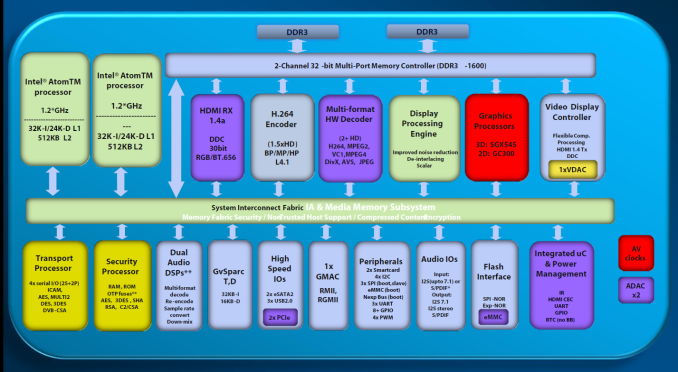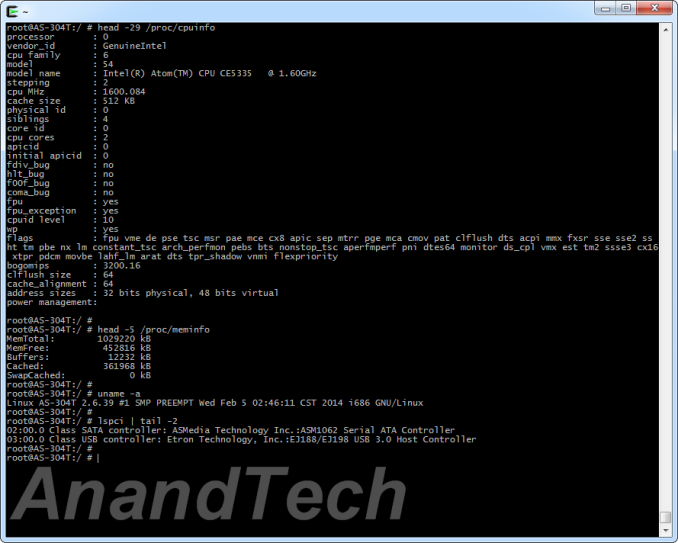
Original Link: https://www.anandtech.com/show/7887/asustor-as304t-4bay-intel-evansport-nas-review
Asustor AS-304T: 4-Bay Intel Evansport NAS Review
by Ganesh T S on March 26, 2014 11:15 AM EST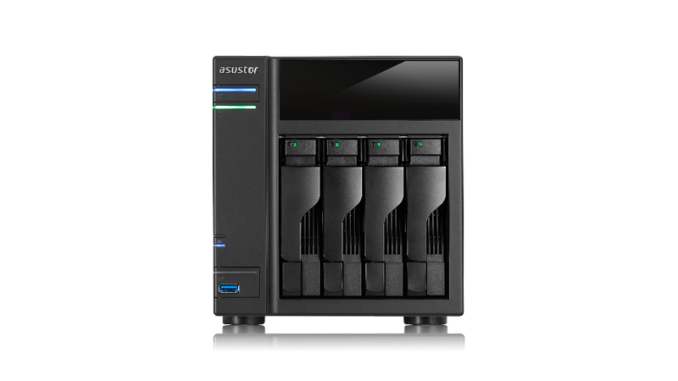
Introduction
NAS units targeting home consumers have traditionally been underpowered in terms of hardware as well as firmware features. Low power, reduced cost and media-centric features are primary requirements in this area. Intel has traditionally been loath to participate in this market segment, probably due to the obvious lack of high margins. However, the explosive growth potential in the consumer / SOHO NAS market has made Intel rethink its strategy.
The Atom CE5300 series was initially introduced as the Berryville set-top-box platform in March 2012. Almost a year later, the CE5300 series was re-launched in its Evansport avatar as a storage solution targeting home consumers (in particular, as a media server platform). Asustor, Synology and Thecus were touted as partners building NAS units based on this platform. We have already looked at the 2-bay Evansport model from Thecus, the N2560. How does the platform perform when scaled up to 4-bays? The Asustor AS-304T gives us a chance to find out.
Asustor places their two Evansport models under the 'Home to Power Users' category. Both of them are based on the Intel CE5335 CPU, and come with 1 GB of RAM. The specifications of the review unit are as below.
| Asustor AS-304T Specifications | |
| Processor | Intel Evansport CE5335 (2C/4T Atom (Bonnell) CPU @ 1.6 GHz) |
| RAM | 1GB DDR3 RAM |
| Drive Bays | 4x 3.5 / 2.5" SATA HDD / SSD (Hot-swappable) |
| Network Links | 1x 1 GbE |
| USB Slots | 2x USB 3.0, 2x USB 2.0 |
| eSATA Slots | None |
| Expansion Slots | None |
| VGA / Display Out | HDMI / 3.5mm Audio Jack |
| Full Specifications Link | Asustor AS-304T Specifications |
| Retail Price | $478 |
In the rest of the review, we will cover the hardware aspects of the AS-304T and provide some setup and usage impressions. This is followed by benchmarks in single and multi-client modes. For single client scenarios, we have both Windows and Linux benchmarks with CIFS and NFS shares. We will also have some performance numbers with encryption enabled. In the final section, power consumption numbers as well as RAID rebuild times will be covered along with some closing notes.
Testbed Setup and Testing Methodology
Our NAS reviews use either SSDs or hard drives depending on the unit under test. While rackmounts and units equipped with 10GbE capabilities use SSDs, the others use hard drives. The Asustor AS-304T was evaluated using four WD Re (WD4000FYYZ) drives to keep comparisons consistent across different NAS units. Evaluation of NAS performance under both single and multiple client scenarios was done using the SMB / SOHO NAS testbed we described earlier.
| AnandTech NAS Testbed Configuration | |
| Motherboard | Asus Z9PE-D8 WS Dual LGA2011 SSI-EEB |
| CPU | 2 x Intel Xeon E5-2630L |
| Coolers | 2 x Dynatron R17 |
| Memory | G.Skill RipjawsZ F3-12800CL10Q2-64GBZL (8x8GB) CAS 10-10-10-30 |
| OS Drive | OCZ Technology Vertex 4 128GB |
| Secondary Drive | OCZ Technology Vertex 4 128GB |
| Tertiary Drive | OCZ RevoDrive Hybrid (1TB HDD + 100GB NAND) |
| Other Drives | 12 x OCZ Technology Vertex 4 64GB (Offline in the Host OS) |
| Network Cards | 6 x Intel ESA I-340 Quad-GbE Port Network Adapter |
| Chassis | SilverStoneTek Raven RV03 |
| PSU | SilverStoneTek Strider Plus Gold Evoluion 850W |
| OS | Windows Server 2008 R2 |
| Network Switch | Netgear ProSafe GSM7352S-200 |
Thank You!
We thank the following companies for helping us out with our NAS testbed:
- Thanks to Intel for the Xeon E5-2630L CPUs and the ESA I-340 quad port network adapters
- Thanks to Asus for the Z9PE-D8 WS dual LGA 2011 workstation motherboard
- Thanks to Dynatron for the R17 coolers
- Thanks to G.Skill for the RipjawsZ 64GB DDR3 DRAM kit
- Thanks to OCZ Technology for the two 128GB Vertex 4 SSDs, twelve 64GB Vertex 4 SSDs and the RevoDrive Hybrid
- Thanks to SilverStone for the Raven RV03 chassis and the 850W Strider Gold Evolution PSU
- Thanks to Netgear for the ProSafe GSM7352S-200 L3 48-port Gigabit Switch with 10 GbE capabilities.
- Thanks to Western Digital for the two WD Re hard drives (WD4000FYYZ) to use in the NAS under test.
Hardware Aspects & Usage Impressions
The Asustor AS-304T comes with a built-in PSU, which reduces the unit's footprint (thanks to the absence of a power brick). The unit maintains the standard industrial design for a 4-bay desktop NAS in the tower form factor, and the choice of materials for the chassis as well as the drive bays is quite acceptable. The front side of the unit has the power button the top and a USB 3.0 slot at the bottom on the left side, while the four bays (and what appears to be a slot for a display) make up the right side. On the rear side of the unit, we have a single 120mm fan , a RJ-45 Ethernet port, and two USB 2.0 ports. Above the USB 2.0 ports, we have a HDMI 1.4a and a USB 3.0 port as well as a 3.5mm audio jack. Note that, unlike the Thecus N2560, we don't have an optical SPDIF port. This shouldn't be taken as a negative, since most multimedia use-cases involve transmitting audio through the HDMI port nowadays.
Platform Analysis:
The block diagram below gives the layout of the Intel CE5335 SoC. Typically, x86 NAS units come with dual network ports (capable of port trunking), but units based on Evansport (such as the AS-304T) don't have that because of the lack of support in the platform. This is acceptable, considering that Evansport is supposed to cater to home consumers who want to use the NAS as a media server.
The other important aspect is the available high-speed I/Os. In a NAS platform based on the CE5335, the two SATA ports and two PCIe 2.0 lanes can support up to 4-bays with the help of a SATA - PCIe bridge. There is no native USB 3.0 support in the SoC. Therefore, the AS-304T's USB 3.0 support definitely from a USB 3.0 to PCIe bridge. It can be guaranteed with this information that the platform would not be able to support all the peripherals at full speed because of either the multiplexing of PCIe lanes and / or throttling the connection of the peripheral to the SoC by using lesser number of PCIe lanes than necessary.
One option to determine the components on the board would have been disassembling the unit. Fortunately, Asustor provides SSH access. The screenshot below exposes some of the hardware aspects of the AS-304T.
The two additional SATA ports are provided by the ASMedia ASM1062 which bridges two SATA 6 Gbps ports to a single PCIe 2.0 lane. The USB 3.0 ports are enabled by the Etron EJ188 which bridges two USB 3.0 ports to a single PCIe 2.0 lane.
Setup & Usage:
After connection to the network, the unit obtains a DHCP address (even in diskless mode) and could be setup using the web UI at http://<AS-304T-IP>. The setup process is straightforward. At least one of the bays needs to be populated. The firmware (Asustor Data Master - ADM) can either be uploaded from the local disk, or, in the case of an active Internet connection, downloaded directly from Asustor's site. The UI helpfully provides updates on the progress of the process. After a restart, the user is provided with an option to accept default settings (depending on the network and number of initial hard disks) or manually configure all the settings. An option is also provided to register for an Asustor ID (necessary to be able to download apps for the NAS from Asustor's marketplace).
The UI on the AS-304T is reminiscent of operating a mobile device, with apps and links to settings laid out in a grid fashion. The Storage Manager helps configure / migrate / expand RAIDed volumes and set up iSCSI targets. It also handles disk info (S.M.A.R.T). Options are available to create users and user groups for fine-grained access control to shared folders. The services section allows configuration of CIFS, NFS, AFP, FTP and WebDAV.
The App Central section allows users to install apps in addition to those that come pre-installed with ADM. The Backup & Restore section allows configuration of rsync as well as other backup options (FTP, external device, cloud etc.). The 'Cloud Connect' feature allows configuration of access to the NAS from an external network (either through port forwarding or relay access via Asustor's servers). The System Information option's Dr. Asustor feature provides a single interface to maintain the health of the NAS (including network connectivity, firewall configuration, HDD bad block scanning and backup configuration). A very pleasing interface to monitor the resource usage is also available.
In order to use the media-centric features (such as XBMC), it is necessary to enable the 'Media Mode' through the UI. This dedicates a portion of the system memory (around 256MB) to running X-Windows and related apps (including Chrome and XBMC) on a display connected to the HDMI port of the NAS. Asustor also sells a separate IR remote for easy navigation in XBMC. In any case, we found that standard USB HID-compliant input devices (including wireless keyboard/mouse combos) could be used to control the NAS in Media Mode.
Our testing sequence started with the insertion of a single disk and configuring it in JBOD. After adding another disk, we were able to migrate to RAID-1. The data remained online (as expected) during the process. Adding another drive allowed us to migrate to RAID-5. Addition of yet another disk helped in testing out RAID-5 expansion. Throughout all these operations, the NAS kept the data accessible and the processes got done without any hitch. We tested RAID-5 rebuild by yanking out a disk during operation and re-inserting it. The rebuild process was also uneventful. On the whole, we were very satisfied with the unit's handling of storage operations (including handling of disk failures).
Single Client Performance - CIFS & iSCSI On Windows
The single client CIFS performance of the Asustor AS-304T was evaluated on the Windows platforms using Intel NASPT and our standard robocopy benchmark. This was run from one of the virtual machines in our NAS testbed. All data for the robocopy benchmark on the client side was put in a RAM disk (created using OSFMount) to ensure that the client's storage system shortcomings wouldn't affect the benchmark results. It must be noted that all the shares / iSCSI LUNs are created in a RAID-5 volume.
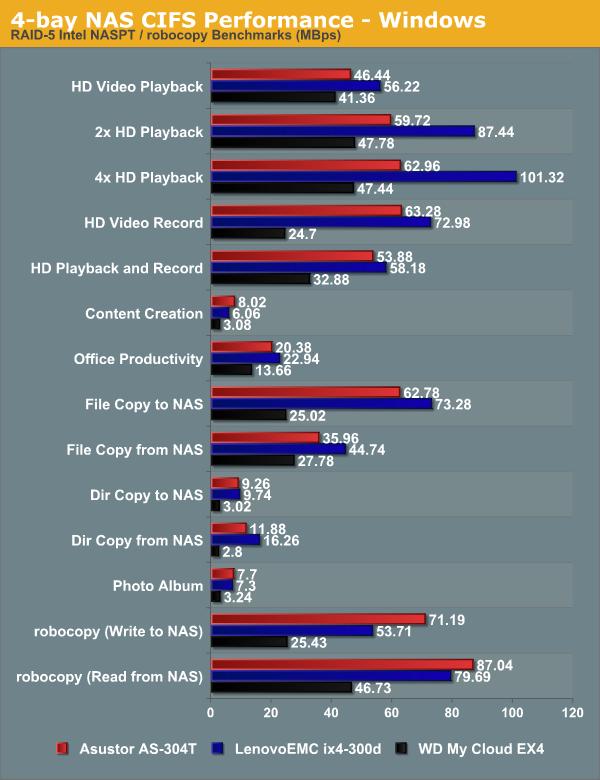
The above numbers present some interesting results. The ARMADA XP-based ix4-300d manages to beat the AS-304T in multiple workloads. Based on the above graph alone, it might appear as if the ix4-300d is much better, but the AS-304T manages to take the lead in certain common workloads as well as feature set (hot-swap capability, for instance).
We created a 250 GB iSCSI target and mapped it on the Windows VM. The same benchmarks were run and the results are presented below. The x86-based AS-304T handily beats the other 4-bay NAS units that we have evaluated (all of which are ARM-based).
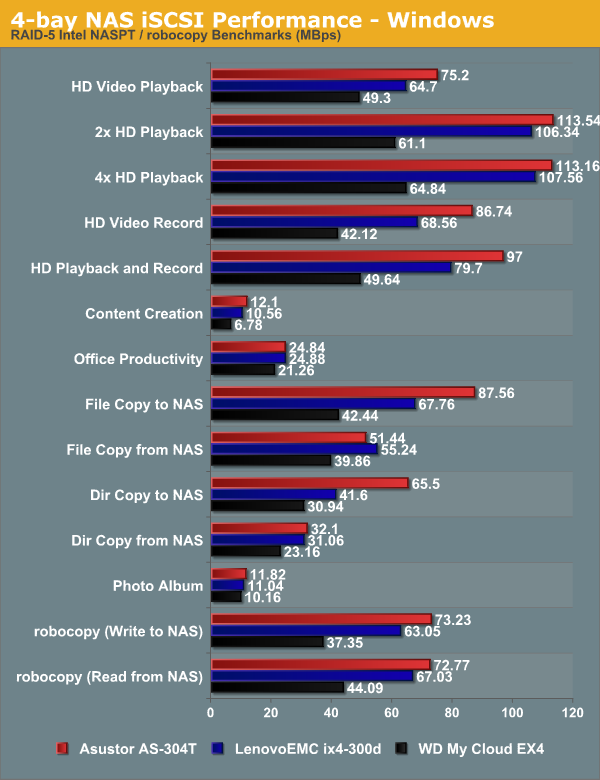
Encryption Support Evaluation
Consumers looking for encryption capabilities can opt to encrypt a iSCSI share with TrueCrypt or some in-built encryption mechanism in the client OS. However, if requirements dictate that the data must be shared across multiple users / computers, relying on encryption in the NAS is the best way to move forward. Most NAS vendors use the industry-standard 256-bit AES encryption algorithm. One approach is to encrypt only a particular shared folder while the other approach is to encrypt the full volume. Asustor supports only folder-level encryption in ADM.
On the hardware side, encryption support can be in the form of specialized hardware blocks in the SoC (common in ARM / PowerPC based NAS units). In x86-based systems, accelerated encryption support is dependent on whether the AES-NI instruction is available on the host CPU. The Atom CPU in the Evansport SoC doesn't support AES-NI, but the SoC does have a security engine. Unfortunately, Asustor's firmware doesn't take advantage of the security engine's APIs. The encryption is done using the host CPU and the performance is hit heavily. We enabled encryption on a a CIFS share to repeat our Intel NASPT / robocopy benchmarks. The results are presented in the graph below
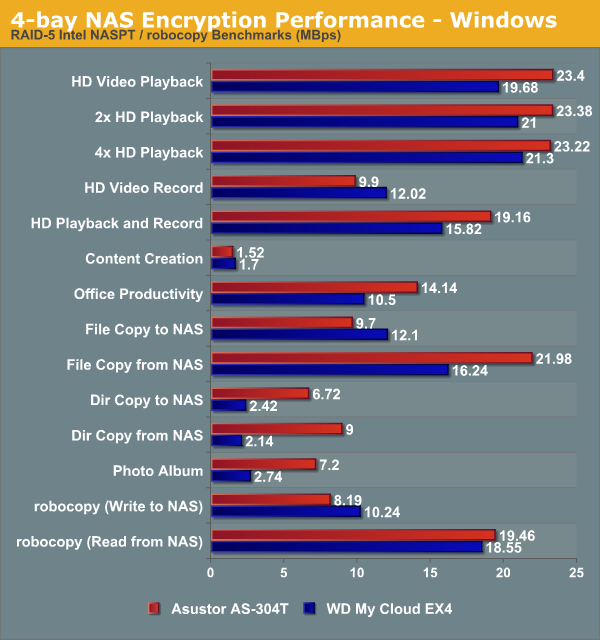
Enabling encryption pulls down the performance numbers, most times by more than 50%. In terms of raw numbers, the performance is sometimes even worse than what can be obtained from ARM-based 4-bay units. If encryption is important, it might be better to wait for the next generation of Atom-based NAS units (the new Atom CPUs have AES-NI) or opt for a higher-end unit sporting a CPU with AES-NI capabilities.
Single Client Performance - CIFS & NFS on Linux
We have recently revamped our Linux-client testing for NAS units, shifting from IOMeter to IOZone. A CentOS 6.2 virtual machine was used to evaluate NFS and CIFS performance of the NAS when accessed from a Linux client. In order to standardize the testing across multiple NAS units, the following parameters were used to mount the NFS and Samba shares:
mount -t nfs NAS_IP:/PATH_TO_NFS_SHARE /PATH_TO_LOCAL_MOUNT_FOLDER
mount -t cifs //NAS_IP/PATH_TO_SMB_SHARE /PATH_TO_LOCAL_MOUNT_FOLDER
Note that these are slightly different from what we used to run in our previous NAS reviews. The following IOZone command was used to benchmark the shares:
IOZone -aczR -g 2097152 -U /PATH_TO_LOCAL_CIFS_MOUNT -f /PATH_TO_LOCAL_CIFS_MOUNT/testfile -b <NAS_NAME>_CIFS_EXCEL_BIN.xls > <NAS_NAME>_CIFS_CSV.csv
IOZone provides benchmark numbers for a multitude of access scenarios with varying file sizes and record lengths. Some of these are very susceptible to caching effects on the client side. This is evident in some of the graphs in the gallery below.
Readers interested in the hard numbers can refer to the CSV program output here. These numbers will gain relevance as we benchmark more NAS units with similar configuration.
The NFS share was also benchmarked in a similar manner with the following command:
IOZone -aczR -g 2097152 -U /nfs_test_mount/ -f /nfs_test_mount/testfile -b <NAS_NAME>_NFS_EXCEL_BIN.xls > <NAS_NAME>_NFS_CSV.csv
The IOZone CSV output can be found here for those interested in the exact numbers.
A summary of the bandwidth numbers for various tests averaged across all file and record sizes is provided in the table below. As noted previously, some of these numbers are skewed by caching effects. A reference to the actual CSV outputs linked above make the entries affected by this effect obvious.
| Asustor AS-304T - Linux Client Performance (MBps) | ||
| IOZone Test | CIFS | NFS |
| Init Write | 55 | 44 |
| Re-Write | 61 | 46 |
| Read | 23 | 95 |
| Re-Read | 23 | 96 |
| Random Read | 13 | 38 |
| Random Write | 45 | 42 |
| Backward Read | 13 | 31 |
| Record Re-Write | 35 | 710* |
| Stride Read | 21 | 68 |
| File Write | 61 | 45 |
| File Re-Write | 58 | 44 |
| File Read | 16 | 66 |
| File Re-Read | 16 | 66 |
| *: Performance number skewed by caching effect | ||
Multi-Client Performance - CIFS
We put the Asustor AS-304T through some IOMeter tests with a CIFS share being accessed from up to 25 VMs simultaneously. The following four graphs show the total available bandwidth and the average response time while being subject to different types of workloads through IOMeter. IOMeter also reports various other metrics of interest such as maximum response time, read and write IOPS, separate read and write bandwidth figures etc. Some of the interesting aspects from our IOMeter benchmarking run can be found here.

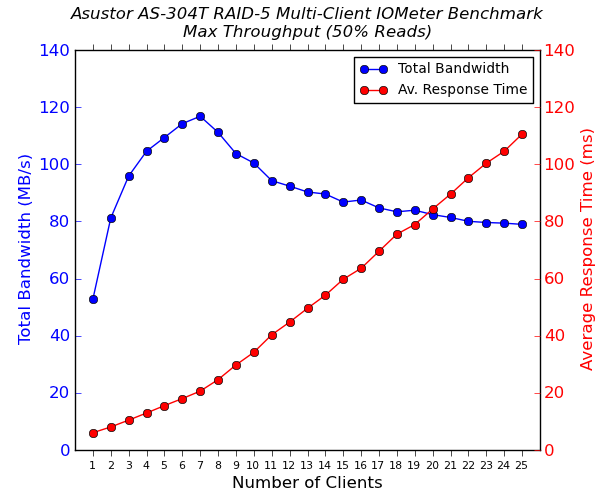
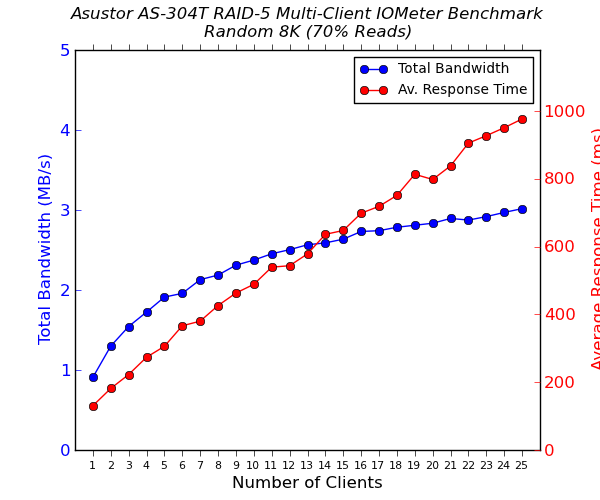
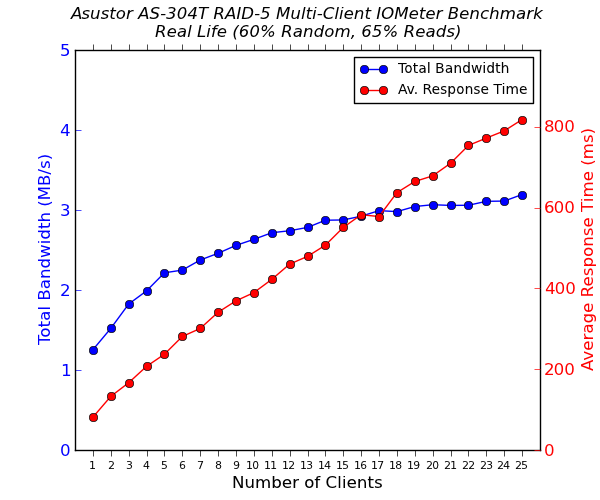
The other 4-bay NAS solutions that we have evaluated before all come with two GbE links. This allows for link aggregation, enabling them to perform well in multi-client scenarios. We find that the single network link of the AS-304T acts as a bottleneck. Beyond eight simultaneous CIFS connections, the performance even starts to suffer a bit for certain workloads. That said, the AS-304T does manage to hold its own when it comes to performance consistency in terms of average response times.
Miscellaneous Aspects & Final Words
The Asustor AS-304T is a 4-bay NAS, and most users are going to use it in a RAID-5 configuration for optimal balance of redundancy and capacity. Hence, we performed all our expansion / rebuild testing as well as power consumption evaluation with the unit configured in RAID-5. The disks used for benchmarking (Western Digital WD4000FYYZ) were also used in this section. The table below presents the average power consumption of the unit as well as time taken for various RAID-related activities.
| Asustor AS-304T RAID Expansion and Rebuild / Power Consumption | ||||
| Activity | Duration | Avg. Power | ||
| Idle (No Disks) | 17.02 W | |||
| Single Disk Init (4TB in JBOD) | 18m | 28.03 W | ||
| 4 TB JBOD (1D) to 4 TB RAID-1 (2D) | 10h 12m | 39.15 W | ||
| 4 TB RAID-1 (2D) to 8 TB RAID-5 (3D) | 1d 0h 13m | 49.64 W | ||
| 8 TB RAID-5 (3D) to 12 TB RAID-5 (4D) | 1d 8h 11m | 59.61 W | ||
| 12 TB RAID-5 Rebuild (4D) | 15h 19m | 59.91 W | ||
Coming to the business end of the review, the performance of the AS-304T is more than acceptable given the target market (home consumers / power users) and the single GbE link. The only complaints we have about the unit are the fact that the firmware doesn't seem to take advantage of all the fancy features that are provided by the Evansport SoC. In particular, we don't have any mobile apps that can make use of the SoC's transcoding capabilities. The security engine is also not utilized to provide better performance with encrypted folders. XBMC and related media functionality are nice features to have (they perform in an excellent manner for the average consumer's media collection comprised of photographs / video from smartphones and camcorders). However, they are not going to satisfy advanced HTPC users (no HD audio bitstreaming support, for example).
On the positive side, Asustor's ecosystem of NAS applications (App Central) is much better than some of other new entrants to the NAS market. The Asustor AS-304T is one of the better designed NAS units (in terms of both hardware and software) that we have come across. The unit made it through all our tests without any hiccups.
During the review process, I happened to install the beta version of ADM 2.1 (since the firmware that was originally shipped with the review unit didn't support encrypted folders properly). There was a little bit of trouble (nothing major, considering that it was a beta firmware), and I filed a bug report using the UI. The prompt attention to the questions / issues from the support engineers was very welcome. The resolution came very soon in the form of a new build. Again, this is much better than the experience I had with the support teams of other NAS vendors.
Asustor initially targeted the EU and Asian markets. They have shifted attention to the US market very recently. Today, Amazon carries the unit for a retail price of $478. While this would have been a very acceptable price for a full-fledged x86-based 4-bay NAS appliance, the fact that the unit only carries a single GbE link makes the price a little difficult to swallow.
From our experience with the unit, we can say without doubt that Asustor is a very effective and welcome addition to the list of SOHO / SMB NAS vendors. We look forward to evaluating more Asustor units that present a better price to features/performance ratio than what is provided by the AS-304T.







